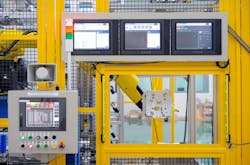Why this article is important
- Presence sensing is increasingly important for both operational efficiency and functional safety in manufacturing environments, especially with the rise of cobots and human-robot collaboration.
- The article details various presence-sensing technologies, such as safety mats, light curtains, laser scanners and radar, specifically applicable to safeguarding human operators around industrial machinery.
- It emphasizes the critical process of risk assessment in determining the appropriate presence-sensing device and the corresponding machine-safety response for each operational step.
- Understanding these technologies and their applications is crucial for controls engineers to design and implement safe and effective automation systems that comply with functional safety standards.
Manufacturing is wrought with safety devices. As we progress further along with cobots and mixing humans and automation together, presence sensing becomes more important, not only for operations, but for functional safety.
Good automation works when we know where the people are and we know where the “things” are, and then we keep the things and the people from colliding in a non-safe arena.
Presence-sensing devices are used to sense the presence of people in the operating area, for the purpose of telling the automation to stop or wait or slow down. The purpose of presence sensing in safety is to reduce the risk of injury.
Manufacturers use a variety of instruments to sense presence. Three main human presence-sensing devices are safety mats, laser scanners and radar devices.
If you are sensing where a thing is, then you may use inductive proximity sensors, capacitive proximity sensors, photoelectric sensors, diffuse photoelectric sensors, through-beam sensors, lasers, fiber optics and ultrasonics. Of course, the simple limit switch is also still in play. The purpose of presence sensing is to track the people and the things, but let’s focus on sensing the presence of people.
When designing an operating area, it’s important to decide on the operation steps and then determine the risks for each step. This allows the engineer to choose the device required for determining presence and then the machine response required to adhere to functional safety standards.
Safety mats
When is a safety mat a good option to use? Mats are good applications when the operator is standing in front of a press that could crush their arms if it moves while the machine is being loaded. Safety mats are susceptible to damage when people are walking on the wires or they get shoved around.
Key takeaways
- Implementing effective presence sensing is increasingly vital for ensuring both the safety of human operators and the reliable operation of automated industrial equipment, especially with the integration of cobots.
- The article introduces key human presence-sensing technologies like safety mats, light curtains, laser scanners and radar, each with distinct operational principles and application suitability.
- A crucial step in machinery design involves conducting a thorough risk assessment of each operational stage to strategically select the appropriate presence-sensing technology and define the necessary machine safety response.
- Advanced presence sensing, like laser scanners and radar, offer enhanced functionalities, such as zone control and 3D detection, which can be integrated into PLC or relay-based safety circuits, albeit potentially with a learning curve.
How does it work? When someone is standing on the mat, the relays drop the safety signals and open the safety circuit. Safety mats respond to the pressure of the weight on top of the mat. When the safety input from the mat is off, then the motor for the press can be alleviated by blocking power to the motor. Once the mat is clear and the safety circuit is reset, then the motor start can be enabled to allow the press to happen. The safety mat is a simple solution and can withstand dirty and busy areas.
Safety light curtains
Light curtains use a beam to block an entrance to an area that can cause harm. If we continue with the press example, then a safety beam could be set up across the front of the press or, even further out, to respond quickly enough to stop the machine before the person is near the danger. If the beam is broken, then the safety circuit drops and stops the machine motion. Light curtains do not work well if people work around them or the reflection gets blocked.
Safety laser scanners
Safety scanners use laser technology to send a light out and get reflection in an area, like a half circle or a whole circle. When the light is reflected, then the software can determine there is a person or object that broke the beam, and it disconnect the safety circuit.
These are more complex, must be programmed and are limited to cleaner areas; metal flakes can set off the beam, depending on the area and the sensitivity. Many laser scanners may be found in operation areas, but they can also be found on the front end of autonomous vehicles. Why? Automated guided vehicles (AGVs) must stop when people walk in front of them. Lasers are also good for differentiating the direction of access to a machine or operation area.
Get your subscription to Control Design’s daily newsletter.
Safety radar devices
Because of the rising use of collaborative robots (cobots),. radar has become more popular for detecting 3D shapes in a safety zone. Radar is an electromagnetic wave-based technology that, like lasers, determines an obstruction when the waves are broken or reflected.
Radar allows more flexibility, in that radar coverage from the ceiling allows for a larger area and makes it easy to detect safety from all angles of a risk. Radar may also be used on autonomous vehicles. Advantages to radar systems is that zones may be set up, so the machine slows as a person or object gets closer to the risk area.
Lasers and radar systems are more advanced and usually require a software application that allows the end user to set up zones and determine programmable logic controller (PLC) or relay inputs. Thus, there may be some learning curve with the application, but, most of the time, it will be plug and play.
With this convenience there is cost, but the increased functionality may make it a better purchase than a mat or light curtain. Again, the trick is to discern the need for the application at hand based on the risk assessment of operator performance and tasks. Either way, there is no reason not to use presence sensing technology to reduce risks in the manufacturing environment.
Next steps
- Research specific functional safety standards relevant to your industry and the types of machinery you build.
- Analyze the safety requirements of current or upcoming machine designs, identifying potential hazards and areas where improved presence sensing could mitigate risks.
- Investigate the technical specifications and costs of the different presence-sensing technologies—mats, light curtains, laser scanners and radar, for example—from various manufacturers.
- Explore training resources or application notes for the more complex presence-sensing devices like laser scanners and radar to understand their programming and integration with control systems.
About the Author
Tobey Strauch
Arconic Davenport
Tobey Strauch is currently managing brownfield installations for controls upgrades at Arconic Davenport. She has previously worked as principal controls engineer and before getting her bachelor’s in electrical engineering, was a telecommunications network technician. She has 20 plus years in automation and controls. She has commissioned systems, programmed PLCs and robots, and SCADAs, as well as managed maintenance crews. She has a broad mix of mechatronics with process control. She enjoys solving problems with Matlab and Simscape. Contact her at [email protected].


